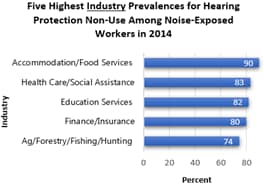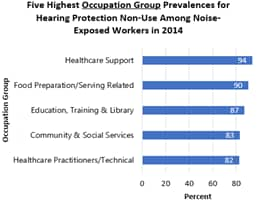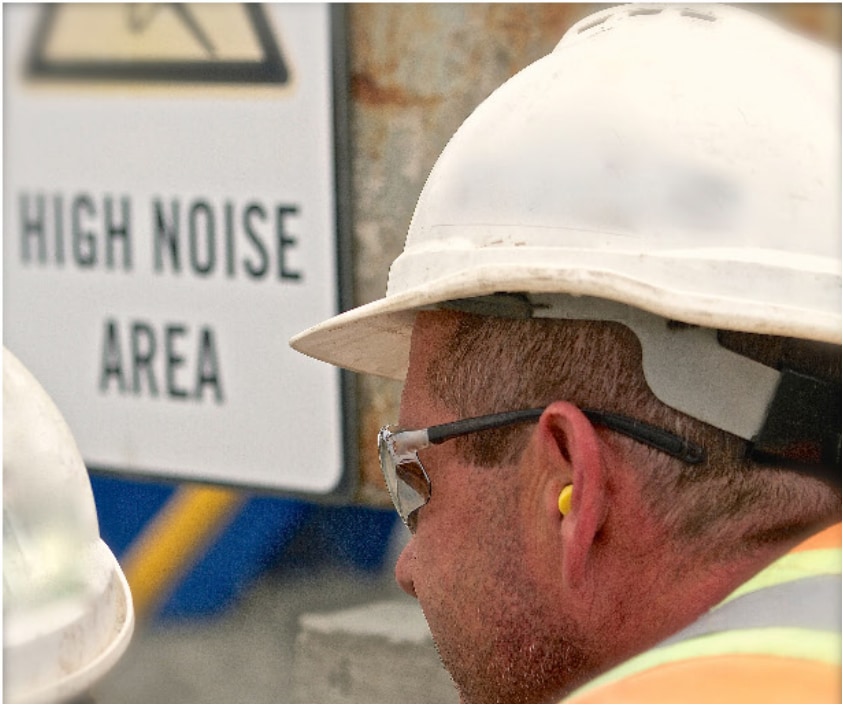Hearing Loss Prevention Program
The National Institute for Occupational Safety and Health (NIOSH) Hearing Loss Prevention Program focuses on reducing occupational hearing loss through:
- researching the evaluation and control of hazardous exposures,
- developing noise controls and ensuring effective hearing protector use,
- performing occupational hearing loss surveillance,
- and providing scientific basis for policies and guidelines that will inform best practices for hearing loss prevention efforts.
The Program works with partners in industry, labor, trade associations, professional organizations, and academia.
- Develop and evaluate engineering and administrative controls to reduce worker exposure to hazardous noise levels.
- Conduct surveillance of occupational hearing loss to identify workers at increased risk and monitor progress in prevention activities.
- Promote evidence based best practices for occupational hearing loss prevention by publishing NIOSH communication products, including guidelines and criteria documents.
- Advance hearing protector and fit-testing technology. This protects workers when engineering or administrative controls have not reduced noise to safe levels.
- Identify, assess, characterize, and reduce risk factors associated with occupational hearing loss. This includes ototoxic chemicals that can cause hearing loss.
- Conducted in-person and virtual workshops related to impulse noise, hearing loss prevention, and communication. This was done for occupational and safety organizations (National Hearing Conservation Association [NHCA] and American Industrial Hygiene Association [AIHA]).
- Contributed key chapters on noise measurement, ototoxic chemicals, and impulse noise exposure to the AIHA Noise Manual 6th Edition.
- Published estimates of hearing protection non-use among noise-exposed workers by industry and occupation using National Health Interview Survey data.
- Published an evaluation of directional microphones with sound measuring apps.
- Published the NIOSH Science Blog NIOSH Noise: A 50-Year Timeline of Research and Intervention.
- Publish a systematic review on the effectiveness of hearing protection fit testing (i.e., in increasing the level of noise attenuation achieved), with and without accompanying training.
- Publish a special issue highlighting NIOSH hearing loss prevention research in the journal Seminars in Hearing.
- Provide a series of webinars for the Council for Accreditation in Occupational Hearing Conservation and the NHCA. The topics were hearing protector fit testing, age-adjustment of hearing screening, and impulse noise.
- Contribute to the International Ototoxicity Management Group. The group aims to address gaps in the management of individuals who experience hearing loss, tinnitus, and/or balance difficulties following medical or occupational exposures to ototoxicants.
- Complete guidance on fit testing of hearing protection and videos on the importance of taking care of your hearing.

Mention of any company or product does not constitute endorsement by the National Institute for Occupational Safety and Health, Centers for Disease Control and Prevention
The Hearing Loss Prevention Program leads efforts to reduce the prevalence of occupational hearing loss. This snapshot shows recent accomplishments and upcoming work.

Source: Adapted from Table II of Green et al. (2021)
10.1080/14992027.2020.1780485

Source: Adapted from Table III of Green et al. (2021)
10.1080/14992027.2020.1780485

NIOSH Workplace Solutions:
Total Worker Health® Concepts to Address Hearing Health
To learn more, visit
https://www.cdc.gov/niosh/topics/noise/default.html
September 2022
